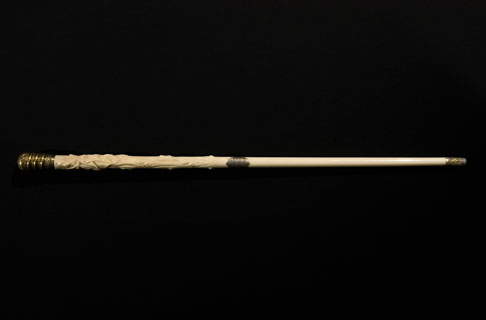
Presentation baton
Maker Unknown
English, ca. 1873
Ivory and gold-plated metal
This ornamental baton is an emblem of the tradition of amateur choral singing, which has been a mainstay of amateur music making in Britain since the 1740s. Choral societies, often with several hundred singing members, were often based in large industrial cities. Music was taught both at schools and colleges of further education, and to be a member was to demonstrate both education and respectability. The standard choral repertoire included oratorios such as Handel’s Messiah (first performed in Dublin in 1742) and Mendelssohn’s Elijah (first performed in Birmingham in 1846; an extract can be heard at the listening station in this room). British composers were more likely to receive commissions for choral than for symphonic works. Outstanding British oratorios include John Stainer’s Crucifixion (1887) and Edward Elgar’s Dream of Gerontius (1900).
The baton was introduced only gradually during the mid-nineteenth century, as the role of the conductor became more dominant. Before that time, ensembles had often been led from the keyboard or from the first desk of the violins, where a bow could serve as a baton. Carl Maria von Weber seems to have conducted with a rolled-up piece of paper, and Mendelssohn was among the first conductors to use a wooden baton. When he produced one in London in 1829, the audience “laughed a little.”
This baton, which could not have been used because of its weight and rigidity, is solid ivory, with three gold-plated mounts. The tip mount is ornamented with arabesque chasing; the butt-end mount has the same arabesque chasing with the appliqué of a coiled serpent. The lower half of the shaft is carved to resemble a branch of holly.
An inscription reads: “presented / to / Mr. J A Matthews / by his cheltenham / choral class / May 1873”
LENT BY THE YALE UNIVERSITY COLLECTION OF MUSICAL INSTRUMENTS
GIFT OF PHYLLIS MATTHEWS
5201.1982
